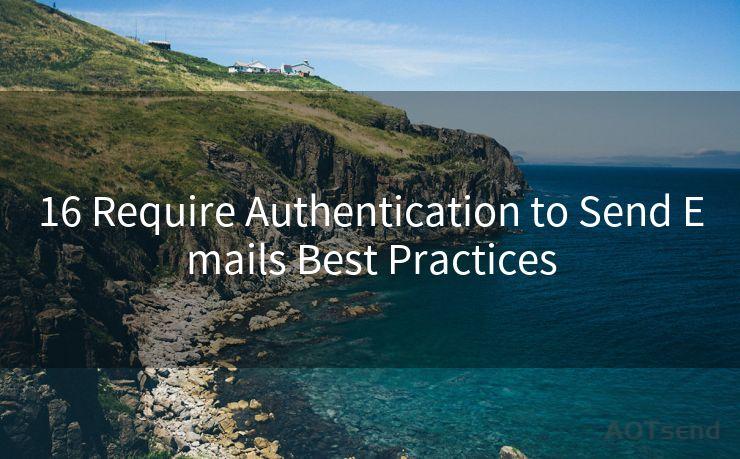16 Require Authentication to Send Emails Best Practices




In the digital age, email communication has become an integral part of our daily lives. However, with the rise of cyber threats and email spoofing, it's crucial to ensure the security of our email systems. One effective way to do this is by implementing authentication measures when sending emails. Here are 16 best practices for requiring authentication to send emails, designed to enhance security and protect your communications.
1. Enable SPF (Sender Policy Framework)
SPF helps prevent email spoofing by verifying the IP addresses authorized to send emails from a specific domain. By implementing SPF, you can reduce the chances of your domain being used in phishing or spam campaigns.
2. Utilize DKIM (DomainKeys Identified Mail)
DKIM adds a digital signature to outgoing emails, verifying their authenticity. This signature ensures that the email hasn't been tampered with during transit, providing an additional layer of security.
3. Adopt DMARC (Domain-based Message Authentication, Reporting, and Conformance)
DMARC combines SPF and DKIM to provide a policy framework for handling unauthenticated emails. It allows domain owners to specify how unauthenticated emails should be treated, such as quarantining or rejecting them.
4. Implement Strong Password Policies
Require complex and unique passwords for email accounts. Encourage users to change their passwords regularly and avoid using easily guessable or common passwords.
5. Use Multi-Factor Authentication
Enhance account security by requiring multiple verification steps, such as a password and a one-time code sent to a mobile device.
6. Regularly Update and Patch Email Systems
Keep your email servers and software up to date with the latest security patches to protect against known vulnerabilities.
7. Educate Users on Email Security
Train employees on email security best practices, including recognizing phishing attempts and avoiding suspicious links or attachments.
8. Monitor and Analyze Email Traffic
Utilize email security solutions that monitor outgoing and incoming email traffic for suspicious activity, such as unusual sending patterns or malicious content.
9. Implement Secure Email Gateways
Deploy secure email gateways that scan incoming and outgoing emails for threats, filtering out malicious content before it reaches users' inboxes.
10. Restrict Access to Email Accounts
Limit access to email accounts to authorized devices and networks, reducing the risk of unauthorized access.
11. Encrypt Sensitive Email Communications
Use encryption tools to secure sensitive email communications, ensuring that only the intended recipient can read the message content.
12. Implement Email Archiving Solutions
Maintain secure archives of email communications for compliance and auditing purposes, while also enabling easy retrieval in case of any security incidents.
13. Regularly Audit Email Accounts and Permissions
Conduct periodic audits to ensure that only authorized users have access to email accounts, and remove any unnecessary permissions.
14. Use Secure Protocols for Email Delivery
Ensure that emails are sent and received using secure protocols like TLS (Transport Layer Security) to protect data in transit.

15. Prepare for Incident Response
Have a clear incident response plan in place to quickly respond to any email security breaches, minimizing potential damage.
🔔🔔🔔
【AOTsend Email API】:AOTsend is a Managed Email Service for sending transactional emails. Support Email Types: reminders, authentication, confirmations, notifications, verification codes, invoices, password resets, account activations, billing statements, two-factor authentication (2FA), and one-time passwords (OTP) emails, etc. $0.28 per 1000 Emails. 99% Delivery, 98% Inbox Rate.
You might be interested in:
Why did we start the AOTsend project, Brand Story?
What is a Managed Email API, How it Works?
Best 25+ Email Marketing Platforms (Authority,Keywords&Traffic Comparison)
Best 24+ Email Marketing Service (Price, Pros&Cons Comparison)
Email APIs vs SMTP: How they Works, Any Difference?
16. Stay Vigilant and Adaptive
As email threats evolve, stay vigilant and adapt your security measures accordingly. Regularly review and update your email authentication practices to address new risks.
By following these 16 best practices for requiring authentication to send emails, you can significantly enhance the security of your email communications and protect your organization from cyber threats. Remember, email security is an ongoing effort, and staying proactive and vigilant is key to maintaining a robust defense against evolving cyber risks.




Scan the QR code to access on your mobile device.
Copyright notice: This article is published by AotSend. Reproduction requires attribution.
Article Link:https://www.mailwot.com/p6818.html



